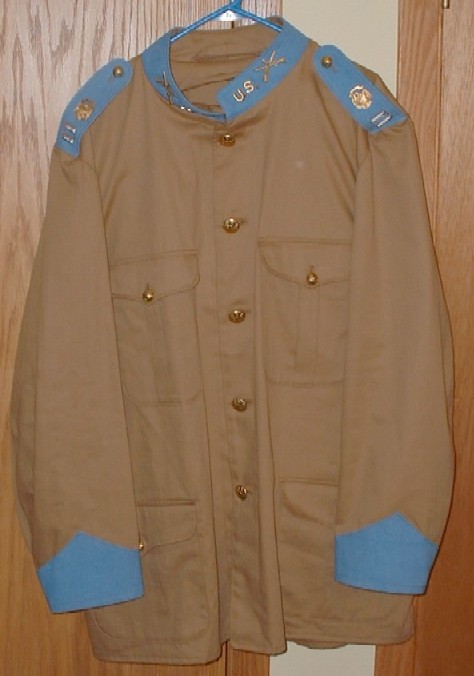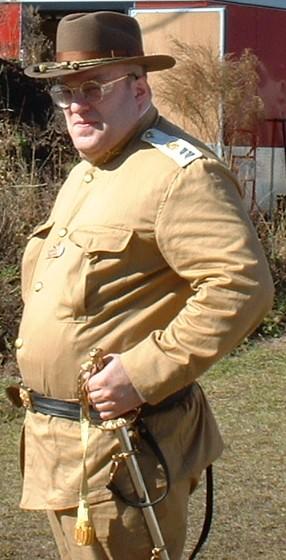The Quartermaster Shop’s M1898 & M1899 Khaki Uniforms
Reviewed By
David L. Velleux
AKA
Captain David P. Barrett
Brevet Lieutenant Colonel, Grand Army of the Frontier
Brigade Assistant Adjutant General
1st U.S. Infantry Regiment
Regimental Adjutant
Single Action Shooting Society Life Member
Honored by the request of my good friend, Private Chuck Casada of Company C, 9th U.S. Infantry Regiment
to write a review of The Quartermaster Shop’s (TQS) Khaki Uniforms for his newletter, I was
happy to oblige. While I am not currently a reenactor for the Spanish-American
War era, rest assured, I am the most authentically attired competitor at
every SASS match I attend. And I have the pictures of the Uniforms I wear to prove it.
I originally contacted TQS about
a khaki uniform over two years ago. While they could not provide it then, they
certainly can now. And I proudly state I had a big hand in ensuring this new
Uniform lives up to the quality one expects from TQS, trading many an email
discussing various details with Jeff O’Donnell. And I believe these chats
resulted in two very good replica uniforms.

Model 1898 Infantry Khaki
Blouse
First is the Model 1898 Infantry Officer Khaki Blouse. The 1898 Uniform Regulations stated the
Khaki Field Uniform Blouse must have certain design elements, such as:
- 2” Wide Plait running from collar to skirt hem down the back
- Collar, attached epaulets and false cuffs colored to the soldier’s assigned branch
- Four patch pockets, the upper two with ¾” wide plaits in them
Simply stated, the Model 1898 Khaki Uniform has all these
details down to a tee. The proper Light Sky Blue color for Infantry is
preserved, as seen in the picture. Please note: I was the person who dyed the
Light Sky Blue cloth used on this Blouse. Jeff stated he could not find a
suitable fabric, so I “improvised” and it turned out well. A minor point TQS
did NOT get right is the second eyehook to secure the collar in the front.
Additionally, the weight of the Khaki material is slightly lighter than what
the originals used, 6-ounce fabric compared to 7-8 ounce. Some may also argue
about the fabric color being off, but one must note all the originals have
faded over the years and there was no official color standard for Khaki
uniforms. The detailing on this Uniform is especially good, however they did
use khaki-colored thread when sewing on the blue-colored collar, epaulets and false
cuffs. And I had a “push through” when I fastened a pocket and the button
missed the hole as it went through the side of the cloth. No biggie, but I will
send it back to TQS for repair once I get the time. Overall, the Model 1898
Khaki Uniform is a quality repro uniform to add to your collection.
 Model 1899 Khaki Blouse
Model 1899 Khaki Blouse
The Model 1899 Khaki Uniform is quite similar to, while very different from, the preceding M1898
version. While the Officer Blouse retains the standing collar, the Enlisted model has a more
comfortable falling collar. The false cuffs are still present, but are made of the same fabric as
the Blouse. The lower two pockets are still plain-faced, but they are moved more to the front of
the Blouse. Only the detached tabs on the shoulders are keyed to the branch color for the soldier.
The 2” back plait was deleted on this model Blouse, per a specification first written in September 1898.
Jeff O’Donnell informed me the M1899 Blouse was the first item worked on to produce the Khaki
uniform.
I was pleased with the overall quality, but the eyehooks
securing the detachable tabs at the shoulder seam are a bit flimsy: Stronger
ones should be used for increased durability. As per Regulations, the tabs on
my Blouse are white, correct for Infantry, but they used the khaki thread on
the white again. For the record, the sleeves on my M1899 Blouse were initially
too long and TQS is in the process of correcting that oversight right now. I do
NOT slight TQS at all: this is a brand new production item and I had the
honor of buying the very first ones to roll off the production line.
Model 1898 & Model 1899 Trousers
With the matching Khaki Trousers, each of the two models
follows the lines of the Model 1884 Foot Trousers. But the comfort factor is MUCH
higher. The 6-ounce Khaki cloth is oh so comfortable to wear and DEFINITELY
does not weigh as much as the aforementioned wool trousers. The 1898 version is
basically identical to the M1884 Foot Trousers, while the 1899 style has two
hip pockets in the back and can be ordered with belt loops. Suspender buttons
will be sewn on the inside of the beltline if one orders the belt loops. TQS
advertises a lace-up outseam system for the 1899 model, but I requested it made
into my two pairs of 1898 trousers. The fit and finish of these Trousers is
superb, as fine or better than one could buy at Wal-mart or another clothing
outlet.
Insignia of Rank & Branch
Just a quick note about the proper use of Insignia with
either of these Blouses: All the Insignia should be of the detachable false
embroidered (Etruscan) type and made of metal. In the 1898 Uniform Regulations,
the Khaki Uniform was listed as an Undress uniform, hence it was to be
“detailed” the same as the other Undress Uniforms of the day: the Model 1895
Tunic and the Model 1898 Wool Undress Blouse. This meant the letters U.S. or
U.S.V. WERE SUPPOSED TO BE WORN on the collar 1” back from the front
edge. Only Officers wore Etruscan branch Insignia 5/8” behind the letters.
With the 1899 Uniform Regulations, the U.S. or U.S.V.
letters WERE EXPRESSLY PROHIBITED FROM BEING WORN on the Khaki Uniform,
now considered a Field Uniform. Officers wore their branch Insignia on the
collar and rank insignia on the epaulets/tabs. Enlisted troops wore chevrons
color-keyed to their assigned branch on their sleeves.
With both Uniforms, Officers Colonel and higher wore the
Arms of the United States on the collar, in place of the letters U.S. or U.S.V.
on the 1898 Blouse only, with Colonels only wearing them ahead of their
assigned branch Insignia. All Officers Lieutenant Colonel and lower wore the
Arms of the United States centered on their epaulets between the button and
their rank insignia, with Second Lieutenants showing only the Eagle, since the
single gold bar did not make its appearance until World War I.
Conclusions
With any new item by a vendor, there are bound to be
“glitches” in the learning curve for each item. I had the Honor/Misfortune of
being the first to buy these new Uniform items. However, I am EXTREMELY
happy and satisfied with my purchases. I hope you would be as well. Cuba
Libré!!!

